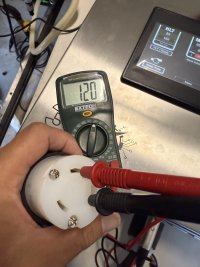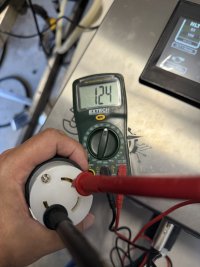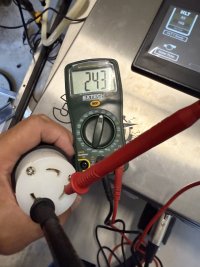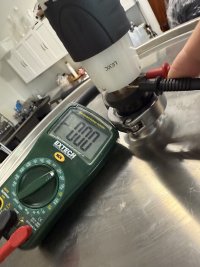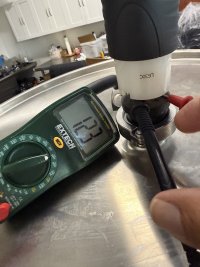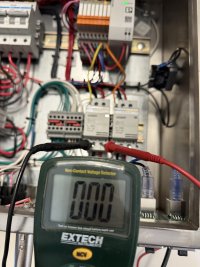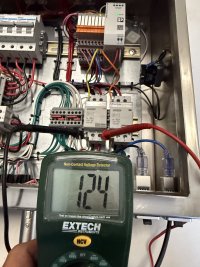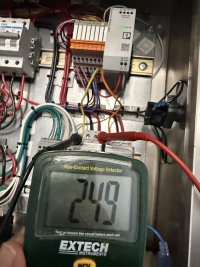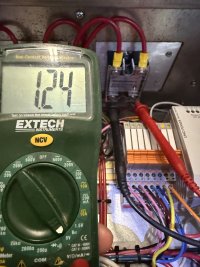Does anyone have the wiring diagram for the Electric Brewing Supply - 360 Series 2-element Control Panel. I have 240V thorough out the controller until it gets to the DIN Rail Connecter going to my HLT and BK element plug inlet. With a regular multi meter it reads fine but with a LoZ meter, it is not getting the correct voltage. I looked on the site but did not see any for this model. Thanks
You are using an out of date browser. It may not display this or other websites correctly.
You should upgrade or use an alternative browser.
You should upgrade or use an alternative browser.
Electric Brewing Supply - 360 Series 2-element Control Panel
- Thread starter lmr275rgr
- Start date

Help Support Homebrew Talk:
This site may earn a commission from merchant affiliate
links, including eBay, Amazon, and others.
Did you actually have a problem with the operation of the controller? I'm 99% sure that Low Z mode doesn't work on SCR (how the SSR works) circuits. What if you set the meter to AC volts?
The reason your image1(2) is correctly showing 120v between L1 and Ground is that it's the hot line that DOESN'T go through the SSR.
In other words, it looks like you don't have a problem.
The reason your image1(2) is correctly showing 120v between L1 and Ground is that it's the hot line that DOESN'T go through the SSR.
In other words, it looks like you don't have a problem.
.
Hope this makes sense. With a Voltage Meter I check the end of the end of the element power cord and get 240V between the two hot (white and black) and 124 between ground and hot (green and black, green and white). (All is good) When I connect it to a 240V, 5500w element (partially plugged in) and check with a load on it, both hot black and white are 0 volts and both hot with ground are 124V.Did you actually have a problem with the operation of the controller? I'm 99% sure that Low Z mode doesn't work on SCR (how the SSR works) circuits. What if you set the meter to AC volts?
The reason your image1(2) is correctly showing 120v between L1 and Ground is that it's the hot line that DOESN'T go through the SSR.
In other words, it looks like you don't have a problem.
Is that when the meter is in LOW Z mode or set to AC volts?
When you put a load on the cable with the element, does it heat when the controller is calling for heat?
If not, can you verify that the SSR is getting 12 VDC on the control terminals?
If yes, can you verify that the red LED on the SSR is lit?
When you put a load on the cable with the element, does it heat when the controller is calling for heat?
If not, can you verify that the SSR is getting 12 VDC on the control terminals?
If yes, can you verify that the red LED on the SSR is lit?
Your readings appear to be consistent with an SSR that is not turning on, so @Bobby_M 's advice to look at the input voltage on the SSR control inputs (terminals 3 & 4) is a good place to start. The SSR should turn on if the control input voltage is greater than 3V (DC), even tho the nominal voltage for most PID control outputs is ~12V. If the light on the SSR comes on, that just means that the SSR is receiving an adequate control input. It does not mean that the SSR is actually working, as the TRIAC, which is the actual power switch, is electrically isolated from the control input (they are optically coupled.) If the TRIAC, or it's triggering circuit in the SSR, has failed, the light on the SSR will still come on when a valid control voltage is applied.
If you want to test the SSR independently of the PID, you can disconnect the wires from SSR terminals 3 & 4, and connect a nine volt battery (make sure you get the polarity right) to terminals 3 & 4, which should turn the SSR on unless it has failed. With this test you should measure ~240 volts across L1 & L2 at the element (partially plugged in.)
Brew on
If you want to test the SSR independently of the PID, you can disconnect the wires from SSR terminals 3 & 4, and connect a nine volt battery (make sure you get the polarity right) to terminals 3 & 4, which should turn the SSR on unless it has failed. With this test you should measure ~240 volts across L1 & L2 at the element (partially plugged in.)
Brew on


$28.98
Five Star - 6022b_ - Star San - 32 Ounce - High Foaming Sanitizer
Great Fermentations of Indiana

$53.24
1pc Hose Barb/MFL 1.5" Tri Clamp to Ball Lock Post Liquid Gas Homebrew Kegging Fermentation Parts Brewer Hardware SUS304(Liquid MFL)
yunchengshiyanhuqucuichendianzishangwuyouxiangongsi

$58.16
HUIZHUGS Brewing Equipment Keg Ball Lock Faucet 30cm Reinforced Silicone Hose Secondary Fermentation Homebrew Kegging Brewing Equipment
xiangshuizhenzhanglingfengshop

$53.24
1pc Hose Barb/MFL 1.5" Tri Clamp to Ball Lock Post Liquid Gas Homebrew Kegging Fermentation Parts Brewer Hardware SUS304(Liquid Hose Barb)
Guangshui Weilu You Trading Co., Ltd

$33.99 ($17.00 / Count)
$41.99 ($21.00 / Count)
2 Pack 1 Gallon Large Fermentation Jars with 3 Airlocks and 2 SCREW Lids(100% Airtight Heavy Duty Lid w Silicone) - Wide Mouth Glass Jars w Scale Mark - Pickle Jars for Sauerkraut, Sourdough Starter
Qianfenie Direct

$10.99 ($31.16 / Ounce)
Hornindal Kveik Yeast for Homebrewing - Mead, Cider, Wine, Beer - 10g Packet - Saccharomyces Cerevisiae - Sold by Shadowhive.com
Shadowhive

$22.00 ($623.23 / Ounce)
AMZLMPKNTW Ball Lock Sample Faucet 30cm Reinforced Silicone Hose Secondary Fermentation Homebrew Kegging joyful
无为中南商贸有限公司

$176.97
1pc Commercial Keg Manifold 2" Tri Clamp,Ball Lock Tapping Head,Pressure Gauge/Adjustable PRV for Kegging,Fermentation Control
hanhanbaihuoxiaoshoudian

$7.79 ($7.79 / Count)
Craft A Brew - LalBrew Voss™ - Kveik Ale Yeast - For Craft Lagers - Ingredients for Home Brewing - Beer Making Supplies - (1 Pack)
Craft a Brew
used voltage meter. End of element power cord has 240V on hots, and 124V and 120 on other to legs. When I plug in element it does not get hot. With 0V hots and 123V on other two legs.Is that when the meter is in LOW Z mode or set to AC volts?
When you put a load on the cable with the element, does it heat when the controller is calling for heat?
If not, can you verify that the SSR is getting 12 VDC on the control terminals?
If yes, can you verify that the red LED on the SSR is lit?
Attachments
Thanks. The SSR light does not turn on and getting 1.24V. How does the PID affect the SSR. @Bobby_MYour readings appear to be consistent with an SSR that is not turning on, so @Bobby_M 's advice to look at the input voltage on the SSR control inputs (terminals 3 & 4) is a good place to start. The SSR should turn on if the control input voltage is greater than 3V (DC), even tho the nominal voltage for most PID control outputs is ~12V. If the light on the SSR comes on, that just means that the SSR is receiving an adequate control input. It does not mean that the SSR is actually working, as the TRIAC, which is the actual power switch, is electrically isolated from the control input (they are optically coupled.) If the TRIAC, or it's triggering circuit in the SSR, has failed, the light on the SSR will still come on when a valid control voltage is applied.
If you want to test the SSR independently of the PID, you can disconnect the wires from SSR terminals 3 & 4, and connect a nine volt battery (make sure you get the polarity right) to terminals 3 & 4, which should turn the SSR on unless it has failed. With this test you should measure ~240 volts across L1 & L2 at the element (partially plugged in.)
Brew on
Attachments
Last edited:
Similar threads
- Replies
- 20
- Views
- 1K
- Replies
- 4
- Views
- 1K

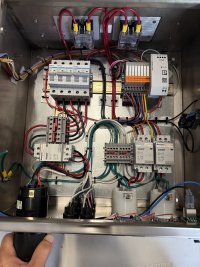
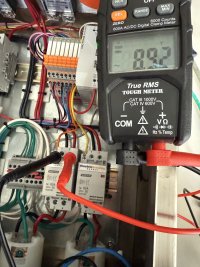
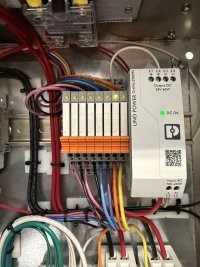
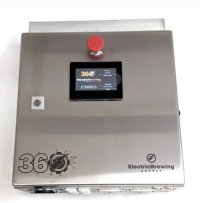
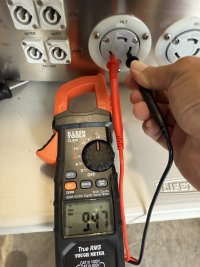
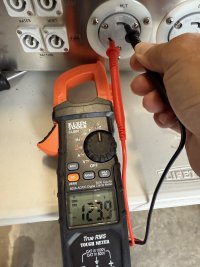
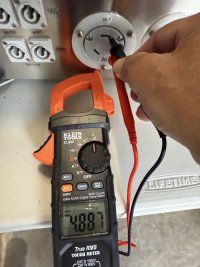


















![Craft A Brew - Safale BE-256 Yeast - Fermentis - Belgian Ale Dry Yeast - For Belgian & Strong Ales - Ingredients for Home Brewing - Beer Making Supplies - [3 Pack]](https://m.media-amazon.com/images/I/51bcKEwQmWL._SL500_.jpg)



























